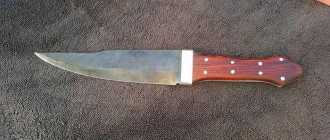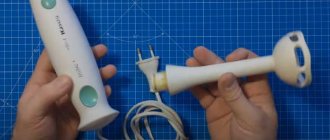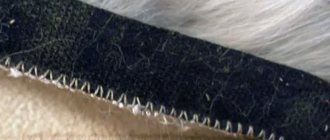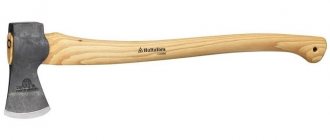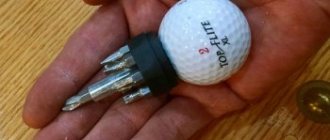The tomahawk is a very practical and convenient tool. But buying such pleasure can be expensive, and the quality of the purchased tools may be less durable. However, you can do it yourself. To do this you will need an old, unnecessary axe, some tools and dexterous hands.
Indian with tomahawk.
Tomahawk axe: history, origin of the name, types and characteristics
It is believed that the word "tomahawk", which gave the ax its name, came from a mispronunciation of the Indian word "tamahakan" - a cutting object.
In pre-Columbian America, the Indians used this word to describe something like “a stone with an elongated shape, sharpened on both edges and mounted on a wooden handle.” And this device didn’t look at all like how it all looks in movies about Indians. It was only with the discovery of America that the word “tomahawk” began to refer to metal axes.
Characteristics and Similarities of Tomahawks
Ax blades have many shapes that roughly resemble a wide variety of axes from different eras or spearheads that lie perpendicular to the shafts. Butts also have several shapes that resemble other axes, such as peckers. Some butts were in the form of hammers or hammers with pins, square and round sections.
However, there was also an ax in the form of a small halberd. Due to its functionality, the ax was used in battle, hunting, and also in everyday life - it was used to cut down trees. The Indians needed this ax only for close combat; they threw it at enemies extremely rarely.
Axes were thrown mainly as sports equipment during training. The functionality of battle axes made it possible to remove the blades from the shafts and use them as a knife. Such axes weighed within half a kilogram, the length of the cutting edges of the blades was up to 100 mm, and the length of the straight shafts was within half a meter.
The emergence of tomahawks
Due to the fact that the manufacture of metal axes was inaccessible to the Indians, they exchanged them from the “pale-faced” who appeared in that area at the beginning of the 17th century. Thus, the first tomahawks were steel and improved battle axes of the British Marines, used for boarding ships.
Spanish tomahawks were different from English ones. They had wide, moon-shaped, rounded blades. The French living in Canada were the first to make tomahawks in the form of klevets.
By exchanging provisions for axes, the Indians turned them into even more formidable weapons. They also learned the technique of using axes and significantly outperformed their teachers, especially in close combat. In throwing, they themselves became unsurpassed masters - all the axes they threw always hit the target from a distance of up to 20 meters.
The functionality of the axes allowed even weak people to use them thanks to the lever handles. The characteristics of tomahawks made it possible to operate both in the thick of battles and in one-on-one combat. In addition, wounded animals were killed with axes.
Birth
The Indian tribes, who lived in isolation for a long time, did not know how to process metal like the Europeans. This did not mean that the indigenous tribes did not fight or hunt.
When the pioneers became acquainted with Indian culture, they discovered interesting weapons. The Indians used a cross between a club and a battle ax as their main weapon. This weapon was called tomahigen and was a long wooden rod with a stone inserted on top.
The handle, made of flexible wood, often broke at the most inopportune moment of the battle. The narrow stone, the striking part, although guaranteed to pierce the head, got stuck in the bones of the skull.
Therefore, when the Indians became acquainted with the metal axes of the Europeans, their delight knew no bounds. The indigenous people willingly exchanged anything for axes, creating their own special culture of handling the battle ax.
The basis of metal tomahawks is the British axe, intended for boarding parties. The soldiers who arrived in the New World did not spare relatively cheap axes in exchange with the Indians. For sailors and Marine soldiers, these axes were commonplace, while for indigenous tribes it was a new word in weapons.
Peace Tubes
Perhaps as the most common type of ax, we can talk about pipe tomahawks. Through channels were made in the shafts of the axes, and the upper parts of the shafts at the holes were plugged with round plugs made of wood, deer antlers, or even metals. Containers for tobacco were placed on the blades on the butt side. The result was an ax-pipe for smoking.
In addition, there were pipe tomahawks, which had sacred meaning. Specifically: “sacred pipes” or “peace pipes.” Special rituals were carried out with the participation of leaders and elders; ax pipes were lit in a circle, symbolizing reconciliation or the end of wars.
The “palefaces,” who respected local traditions, often used pipe axes. They were richly decorated as gifts to the leaders. The blades were engraved and the shafts were decorated with a wide variety of metal details.
Missouri tomahawks
Until the 19th century, some of the most sought-after battle axes were “Missouri.” They got their name from the local Missouri River. A characteristic feature of such axes was the presence of a large blade, which turned into a simple butt with a round eye.
This served as the name for lug tomahawks. The presence of large surfaces of the blades made it possible to make shaped holes for a more attractive appearance. The supply of such axes was carried out by the French living in Canada. Their cheap production made it possible not to harden the blades, because these were battle axes.
Espontone battle axes
The tomahawk shafts did not wedge. Thanks to this, the metal parts of the ax blades could be removed from the shafts and used as combat knives. In addition, such blades were often attached to war clubs that were used by the Indians.
In most cases, cavities were made in esponton tomahawks, like in tubular axes. Sometimes one came across a number of earless espontone axes, similar to the ancient axes of the Celts.
Trade tomahawks
Trade tomahawks are the simplest and cheapest ax of all the tomahawks. They are characterized by the fact that the blades, turning into simple butts, were flat or rounded and were used as hammers.
There were also types of axes whose blades were double-sided. The shafts were inserted both above and below the holes, based on the types and shapes of the axes. Due to their shape, they were called “half-axes”, since they were very small in size.
The Indians used these mini-axes mainly for agricultural work, although also for war. Such axes were supplied by the manufacturing countries themselves: England, France, and Holland.
Origin of tomahawks
The settlers supplied the Indians with metal axes and tomahawks. Most of the tomahawks are made in factories in Europe: in France, England, Holland and Spain. The Spaniards supplied the Indians with axes less than others. But other countries, along with the emerging USA and Canada, supplied hundreds of thousands of them. The Indians could make only the most primitive “things” on their own, but blacksmiths settled with them, who repaired and manufactured various iron objects.
It is believed that tomahawks with wide moon-shaped blades originated from the Spaniards. The British are characterized by various versions of ordinary hatchets. The French of Canada were the first to produce tomahawks in the shape of not a hatchet, but a claw - "". Initially, ordinary European axes came to North America and the Indians. But their parameters turned out to be not entirely suitable. Therefore, the process of selecting and creating our own options was underway. For example, the most popular form has become known even earlier to Europe as the “half-axe”. From about 1700, typical varieties of tomahawks were already widely produced. The bulk of the tomahawks of the eastern part were produced in 1740-1850. In the West they date back to 1830-1890.
The preferences of certain forms of tomahawks among Indians of different tribes changed over time and were determined by the proposals of manufacturers. The strikers or heads of tomahawks were originally made of iron and steel. Later they also began to use bronze or brass. Or a head was made of iron or non-ferrous metal, but a steel blade was inserted into the front part of the blade. Tomahawks made of plain iron without hardening were counterfeits that were sold to the Indians by deception. There were quite a few tube and esponton tomahawks made of soft metals - tin and lead. Moreover, they cannot be called decorative, since they were in use from the War of Independence until the very end of the 19th century.
Halberd-type tomahawks
From English “halberd tomahawks” is translated as halberd tomahawks. These are exact copies of halberds, but with short handles. Mainly used in trade with the natives. The shafts were secured using cone-shaped bushings. This method of fastening was borrowed from copies.
At the ends of the ax shafts there were metal bayonets shaped like a sharp cone. The metal parts of the blades were solid, there were no slots. The shape of the blades was wide and semicircular on one side. While the other side and the top resembled a flat point.
Halberd tomahawks were in the “assortment”. Some had no points on top, and some had chisel-shaped points. In some, the points were replaced by curved hooks, spikes or smoking cups.
There were models with collapsible heads that could be screwed onto vertical bushings with threaded points. In addition, each of the points could be attached, of course, if there was a cut thread. There were also tomahawks that did not have bushings for the shafts, since they were entirely metal.
Later, tomahawks with shafts made of brass and other metals appeared. They were inserted into sockets and riveted using rivets. Such shafts had a wide variety of shapes. They were flat, round, pointed at the ends.
Despite the fact that these products were not convenient for use in battle, the Indians used such axes to demonstrate their belonging to the leaders, because the presence of such axes was a sign indicating the status of the leader.
How and what were tomahawks made from?
Initially, Europeans brought axes intended for work. These were ordinary, strong steel products, widely distributed and used throughout the world. In order for more axes to fit during transportation, they were laid without a handle.
The large wide blade was ground down for ease. The tomahawk, which got its name from the European-style transcription of an Indian word, was often and successfully thrown by Indian warriors at the enemy. The butt changed, it was lengthened, turning into a bite.
Sometimes a recess was made in it for tobacco, a hole was drilled through the handle, complementing the functions of the ax, making it a pipe for smoking. True, such axes were not used in hand-to-hand combat, leaving them as diplomatic equipment.
Since ax suppliers, as well as tribes, varied greatly, there are several of the most popular types of tomahawks:
- eye axe, the most famous type of tomahawk, promoted by cinema;
- tubular, described a little above;
- esponton variants, usually obtained as trophies from sergeants and officers of the colonial troops, were distinguished by their large mass, unsuitable for throwing;
- halberd tomahawks were obtained in the same way as in the version described above, but the basis was an already shortened halberd, rarely found in lands where there were no Spanish conquistadors.
The idea of Indian beauty was fully reflected in tomahawks. The handles were decorated with carvings and ornaments. Feathers, fangs of predators, and scalps of defeated enemies were hung as talismans and amulets.
The blade and butt were also subjected to painting, chasing and other delights worthy of jewelry from the time of the European Great Migration.
Main types of tomahawks
There were also battle axes-tomahawks, with hammers on the butts, or tomahawk-hammers, very similar to pipe axes, but not as elaborate as trade axes with hammers on the butts. Such axes were used not only by the Indians, but also by North American settlers, as well as colonist riflemen, who used them as belt axes.
Axes with points or hooks on the butt side are peak tomahawks, similar to boarding axes. Athapascan clubs can also be classified as tomahawks. These were products made from deer antlers with protruding branches into which points were inserted from whatever was at hand.
Varieties of Indian tomahawk ax
Although the tomahawk for ordinary people is associated with the so-called “Missouri axe,” the type of tomahawk could be different, in particular:
- Celts. The very first iron tomahawks, which were driven into the handle with a butt. The same group includes celts with a point, more like klevets;
- Ear tomahawks. Exactly those that were advertised by cinema and books about Indians. They were otherwise called “Missouri axes” and were a traditional form of an ax with an eye. Used for combat operations, very rarely in everyday life (mainly for quickly cutting up carcasses);
- Pipe tomahawks. They could be of any type, but they had a special feature - a channel along the entire length of the handle. Often richly decorated, they were rarely used in battle due to the hollow handle. Their main purpose was in diplomatic ceremonies between tribes, often given as a sign of friendship;
- Esponton tomahawks. They were a mixture of esponton and axe. Most likely, they were remade from espontons taken in battles with settlers;
- Halberd tomahawks. They were brought from Spain and were either shortened halberds or hatchets made according to the same pattern. The rarest variety, the North American Indians had them mainly among the leaders, emphasizing their status.
Celtic tomahawk
Pipe tomahawks
Esponton tomahawks
Halberd tomahawks
Along with these models, there were homemade tomahawks. They were usually made from standard models.
Tomahawks of our days
Despite the fact that almost 200 years have passed, tomahawks are still relevant today due to their functionality. Mainly attention was paid to them before the Vietnam War.
Currently, the tomahawk ax can be used in tourism and in some sports, but most often it can be seen as a historical reconstruction.
Source
SITE SOURCE
How to make a tomahawk yourself
Among the other variety of homemade edged weapons on this site, we have not deservedly neglected such a unique weapon as the Indian tomahawk.
Only at first glance does this throwing hatchet seem like an anachronism. In fact, this weapon, worthy of a detailed description, is very interesting in terms of sports throwing at a target. Throwing a tomahawk differs in many ways from throwing, for example, the same throwing knife. For now, we will not focus on the methods of throwing a tomahawk and will not delve into the descriptive history of the creation of this weapon by ancient Indian craftsmen. Our goal is to try to make a tomahawk with our own hands at home, so to speak. First of all, for those who decide to make a tomahawk, you need to purchase a blacksmith's forge. But since purchased forges are generally quite expensive, you can make a mini forge yourself. Secondly, you need, if you are not already a blacksmith, to acquire some blacksmithing skills. To do this, contact familiar specialists, or read special literature, practicing on scraps of any metal. Some metal forging technology is described in the sword making section. I think it won't be too different from forging a tomahawk hatchet.
So, in order to forge a hatchet, you need to find a piece of high-carbon steel grade 1095 and 15N20. You can ask the experts and try a different grade of steel. But the author of this tomahawk, a certain Joe Shilaski, recommends this one.
Before we start forging, let's look at what the tomahawk hatchet actually consists of. Look at the drawing and study all its parts, I think this is necessary to clearly imagine what you want to do. Next, we heat the steel billet in the forge
In theory, in order to forge a high-quality billet, a billet is made from several layers, forging them separately and forging welding them together. The author forged a billet of 400 layers, first laying layers of grade 1095 steel, and then grade 15N20. But, for such a complex forging technology, you must be a highly qualified blacksmith specialist. You and I are ordinary home-made craftsmen, and we can be forgiven for forging a tomahawk hatchet from a single piece of metal. Let's assume that you have already done this and forged the ticket.
Now this workpiece needs to be upset to increase the diameter of the steel by heating one end and tapping it with a hammer.
Next, we make the workpiece flat by first adding flux to the steel and placing it in a furnace to bring it to the required heating temperature. When forging a workpiece, constantly inspect it from the sides and top to achieve a symmetrical shape. To give the desired shape, make a wooden template and constantly check the dimensions and shape of the hatchet against it
Once you have achieved the shape you want, the steel needs to be “normalized”. To do this, the workpiece must be heated to a “non-magnetic” state and cooled at room temperature. Then heat it up again and put it in a hot box filled with sand or sawdust to cool.
Now that the rough blank is finished, let's proceed to its further processing, that is, giving it its final shape according to a wooden template
But first you need to remove the scale and do a rough grinding.
Using a large drill, make a hole for the hatchet at a strictly ninety-degree angle relative to the head of the hatchet. Now we clamp the workpiece in a vice and process the hole with a file, achieving the desired shape
In general, now it will be quite labor-intensive and tedious work with a file to select and shape the neck, chevron, butt, molding. But here it depends on the desire to give beauty and authenticity to your tomahawk.
If working with a file is a bummer, you can leave it like that (although in this case the balancing of the tomahawk will be disrupted, so if you want to throw a tomahawk and not stab logs with it, simultaneously hammering nails with the back side, I advise you to complete the work. Balancing is achieved by reducing the layer of metal by neck of the tomahawk head), starting to make the handle.
I think there is no need to describe in detail how to make a tomahawk handle. If you have mastered such a complex process as forging, then carpentry is “seeds” for you.
Another labor-intensive process that awaits us when processing a tomahawk is rough and fine grinding. How to properly grind is described in the same section on making a sword, so I won’t repeat myself and waste my fingertips on the keyboard. After giving the tomahawk its final shape, the ax must be hardened. You can harden the metal in used engine oil by heating it to a temperature of 145 degrees Fahrenheit, for example with a torch. A more detailed description of steel hardening is described in the “steel hardening” section.
The tomahawk hatchet can also be polished to a mirror shine, or given a beautiful color by chemically treating the metal.
And later I will post the coloring methods mentioned above.
The appearance of steel tomahawks among the Indians
The first metal axes were traded by settlers for furs. Having quickly learned to wield tomahawks, the natives surpassed their teachers in this art. The Indians learned the basics of using a tomahawk from British sailors who used axes in naval battles during boardings. Moreover, the Indians were able to master throwing techniques, forgotten in Europe since the times of the Franks, and even surpass the ancient Europeans. Throwing masters could throw several tomahawks in a couple of seconds. The Missouri type of ax was most suitable for throwing. The Spanish halberd-type ax was suitable only for close combat. The ax could be thrown at a distance of up to 20 meters.
Unlike the European battle axe, the tomahawk was not designed to penetrate armor, however, during the heyday of the Indian wars, armor was no longer worn. Due to its light weight and relatively short handle, the ax could deliver many quick slashing blows in battle with several opponents. Moreover, the design of the tomahawk allowed even a physically weak person to inflict deep, often fatal wounds.
Since tomahawks were well sold by local aborigines, manufacturers began to produce axes taking into account the preferences of specific tribes. It is worth noting that at first the axes were made of simple iron, and the eye was not pierced, but bent, followed by welding. Often such eyes burst at the most inopportune moment, especially in the cold.
To save space during transportation, the axes were not equipped with handles, which were made by the Indians with their own hands. When making the handle, it was decorated by the aborigines with truly barbaric luxury. Everything that was at hand was used for decoration, from leather and wire to human hair and even scalps. Without knowledge of metallurgy, the Indians could not independently modernize ax blades. Having learned this only at the beginning of the nineteenth century, they began to forge axes themselves, giving them a more convenient shape.
The civilized market instantly responded to demand and flooded the market with various models of tomahawks. Blades began to be made of steel, welded by forge welding, eyes began to be made with a punch, and the blades themselves were decorated with holes and even inlays.
When many Indian tribes were exterminated and the remaining were driven into reservations, the art of using a tomahawk began to be forgotten until it practically disappeared.
Disadvantages of modern models
Modern industry produces many types of tomahawks for every taste. From the frankly predatory SOG m48, to the quite peaceful-looking Jenny Wren Spike, advertised as women's. In general, modern tomahawks can be divided into three groups:
- Identical. Such axes are produced only by Cold steel. They are a forged hatchet on a wooden handle, put on using the reverse insertion method;
- Tomahawks attached to a plastic handle. This is the notorious SOG m48 and similar models;
- Tomahawks, cut from a single piece of metal, with pads in the handle area.
Modern tomahawk with plastic handle
A tomahawk made from a single piece of metal.
Let's take a closer look at the advantages and disadvantages of each type.
The identical tomahawks are a classic ax design that has remained unchanged for hundreds of years. Usually they are made independently or ordered from blacksmiths. Despite their inconspicuous appearance, they are a formidable weapon, proven in many battles over the centuries. They are distinguished by a simple design, perfect balancing, the ability to adjust the handle specifically to your hand, and ease of repair. The ax itself is “indestructible”, and the handle is easy to make with your own hands.
Tomahawks on a plastic handle have a very menacing appearance. Thanks to their light weight, they can be used at high speed. The butt is often made in the form of a pecker, a hammer, or even a second blade. During operation, these axes revealed many shortcomings. The round handle often rotates in the hand when striking, which is why the blow turns out to be sliding. It is absolutely not suitable for throwing, despite the assurances of the sellers (the handle breaks after several hits against a tree). Practically unsuitable for household work. This type of tomahawk is better suited for intimidation than for serious work.
One-piece tomahawks can be called an ax with great stretch. Rather, these are blades shaped like an ax. Due to the design features and low weight of the working part, they are not capable of performing the role of a powerful piercing weapon. It rubs your hand a lot when using it. Their only advantage is their solid structure, which is very difficult to break.
If you want to purchase a truly real combat tomahawk, choose identical ones from Cold steel, or better yet, make it yourself or order it from a blacksmith.
Revival of the tomahawk in the 20th and 21st centuries
However, Peter's plans to introduce the tomahawk into the standard equipment of the Marines were not destined to come true. After the Vietnam conflict, the tomahawk's popularity declined and the company closed in 1970.
A new surge in the popularity of tomahawks occurred in the 2000s, in connection with the military operations of the US Army in the east. It was perfect for opening doors. Nowadays, so-called “tactical” tomahawks are produced by many companies and everyone can choose an ax based on their needs.
Drawing for making a tomahawk with your own hands
There are two ways to make your own tomahawk:
Let's take a closer look at these two methods, after which we'll figure out how to make a handle.
To forge an ax you will need a forge and an anvil. A forge can be made from an old saucepan by drilling holes in the bottom and partially cutting off the side walls. To blow air in, you can use an old vacuum cleaner or a computer fan. A piece of old rail is suitable as an anvil.
For the ax, 65g metal is suitable. An alternative source of steel is to reforge a car spring. First, a rectangle of suitable thickness is forged, and an eye hole is made in it using a chisel or punch. Then the workpiece is given the desired shape using a forge (or ordinary) hammer. The workpiece is hardened, after which metalworking is carried out.
The hardening of a forged tomahawk should be zone-hardening - the blade is hardened, but the butt is usually not hardened. After metalworking, the ax is mounted on a previously prepared ax handle.
To make a tomahawk you will need a donor - an ordinary ax. As a first prototype, you can take a cheap Chinese ax. It just won't make a quality instrument. Although if you are afraid of ruining a high-quality ax, you can try it in Chinese.
If you want a quality tomahawk, use old Soviet forged axes. Axes from army warehouses of the forties and fifties enjoy good fame.
First you need to make a drawing of a tomahawk. To do this, the donor is placed on a sheet of paper and traced along the contour. This drawing is then given the desired shape. The next operation will be to transfer the drawing from paper to an ax. Having drawn the desired shape on the axe, you should trim off the excess metal using a grinder. Be sure to wear safety glasses and gloves when cutting. Do not cut too quickly, otherwise the metal will overheat and lose its hardening. It is recommended to periodically cool the part with water. After trimming, the workpiece is sharpened on an electric sharpener and polished. If you have a Dremel, you can decorate the ax with a message or design. If the metal overheats during the work, the ax needs to be hardened again.
Tomahawk modification
There are a large number of tomahawks used at different times by representatives of different tribes and organizations.
Earless:
- celts, similar to the first tomahawks of the Indians, but made of metal;
- celts with a point.
Ear:
- Missouri military axes, the head of which in most cases was simply a cut piece of sheet metal;
- tubular with a through channel inside the handle;
- espontone, descended from a polearm with the same name, which was used by officers of European armies;
- with a point or hammer;
- trade axes, used in the fur trade and so named because of this;
- halberd, resembling halberds in appearance.
There are many other tomahawks mentioned in the literature, but these are the most famous.
Tomahawk: modern copy.
Step 1: Raw Materials
After studying the history of the tomahawk, creating a drawing and studying its modifications, you can begin making the tool. The first step is to prepare the materials. To make a tomahawk with your own hands you will need:
- axe;
- wooden block;
- wedge;
- leather, feathers and other details for decoration.
Step 2: Creating the Blade
Tomahawk: manufacturing process.
It is necessary to draw the desired shape on the head of the old instrument. It is worth making it smaller, since tomahawks have a smaller head size and were used by the Indians for throwing.
In addition, it will be lighter, which is a big advantage of the tomahawk.
After selecting the shape, it must be cut out. This can be done using a grinder, after holding the ax in a vice.
Step 3: removing paint from the blade
Metal cleaning products.
If the original ax contains paint, it should be removed. Paint stripper can be purchased at a hardware store.
By following the instructions, you can quickly obtain pure metal. But when working with such substances, you should be careful, as there is a risk of getting a chemical burn.
Step 4: Boil the ax blade in vinegar
This process will make the ax look aged. You need to cook it in white vinegar for 20 minutes, preferably in an old, unnecessary container. It is worth ventilating the room during the cooking process, as the smell can cause dizziness, and it itself is not particularly pleasant.
Step 5: Making the Handle
As with the head, markings are applied to the block, along which the handle of the future tool is cut out.
The appearance of the handle depends on the choice of the creator: it can be a classic round shaft or a handle made to the shape of the owner’s hand
. In this case, it is better to make the handle a little larger, because it can be ground off if necessary.
Step 6: putting the blade on the handle
To fit the head onto the ax handle, it will have to be sanded and adjusted to the size of the eye. The main thing here is not to overdo it, otherwise you will have to cut out a new handle, and this is a waste of time and material.
You need to put it on tightly.
Step 7: Finishing Touch
Here it is at the discretion of the creator. If necessary, you can decorate the tomahawk with various feathers, carvings or leather braiding. Afterwards, you can grind and consider the tool ready.
Step 8: Put it all together
Now that the components are ready, it's time to assemble the tomahawk. You need to put the head on the handle, drive a wedge so that it does not fly off, decorate it with feathers, leather and other things if desired, and the tool is ready!
Making a handle for a tomahawk
Typically, ax handles are made of birch, but for a tomahawk it is better to choose a different wood. Cold Steel uses hickory wood for its tomahawk handles. In our latitudes, the best wood for an ax is ash. It is not inferior in strength to oak and at the same time has good flexibility. You can use dogwood, pear and cherry plum.
The wood for the tomahawk handle must be well dried. If this is not done, during drying the ax will play and may even fly off the handle. When using a reverse thrust, the possibility of the ax flying off is eliminated, but the play will greatly interfere with any work. You need to jam the ax with a wooden wedge, never an iron one.
Source
Simple technology for making a tomahawk
First, you need to find among household steel scrap a piece of sheet iron with a thickness of 4.7 mm to 6.35 mm, and a size of 10 cm by 12.5 cm. If you do not find anything suitable in the garage, then look either in a salvage store or in industrial goods stores. The steel sheet should not be too heavy, but not too light.
Mark the plate: 8.89 cm high by 12.5 cm wide, with a radius as shown in the picture. You can make the curvature from the blade to the butt arbitrary, it’s not important. In the picture, by the way, the dimensions are indicated in inches.
To save time and effort, cut the tomahawk blade blank using a grinder or a gas cutter. If you have neither one nor the other, then use a vice and a hand hacksaw the old fashioned way.
Now, using an emery machine (stationary or manual), tomahawk.
Next, we will need a piece of steel pipe, which we will saw off to the size of the blunt edge of the tomahawk blade. Next, using a welding machine, carefully weld the tomahawk blade to the middle of the pipe. At the same time, try to match the axial relationship of the edge of the tomahawk blade and the center of the pipe as accurately as possible so that your throwing tomahawk does not look crooked.
After you have welded the blade to the tube that will serve as the handle socket, clean the weld.
Next we need to find a handle for the handle. You can use cuttings of hillers, shovels, etc. for this. In principle, when selecting a pipe for the handle fastening coupling, you must immediately take into account the diameter of the pipe, so that you can select a handle of the required diameter that fits very tightly into it.
To keep the handle tightly in the tomahawk, do the following. We cut off a piece 43 centimeters long from the cutting. We cut an internal thread in the pipe and screw the prepared handle into it, holding the tomahawk blade in a vice. Now the handle will definitely not go anywhere and will not become loose when throwing.
Those who do not have a thread cutting device can make it even easier. Drill a couple of holes in the pipe and attach the handle. Then screw the screws into these holes, thereby firmly securing the handle to the tomahawk.
All that remains is to finally polish the tomahawk handle, treat it with antiseptic or oil, and sharpen the tomahawk blade to a razor sharpness. If you wish, you can burn designs on the handle and then soak it in oil. Special antiseptic oils are sold, but you can use regular sunflower oil for this. This is done as follows. The handle is soaked in sunflower oil and dried in a very hot oven. Then it is soaked again and “fried” in the oven again. After such treatment, no moisture or rotting will be scary for it. The tomahawk blade can also be subjected to some kind of processing, for example, bluing. Good luck!
When you hear the word “tomahawk,” many people immediately think of Indians. Indeed, this type of ax was masterfully used by North American aborigines. Reading books about Indians, it is difficult to escape the impression that the small steel hatchet is an original Indian invention. In fact, the Indians only gave their name to this axe, and it itself arrived in America along with the colonists.
The first axes among the Indians of the pre-Columbian era were made of stone, mounted on a long handle, often flexible or made of willow twigs. This ax was a hybrid of an ax and a club and was used in war and in everyday life. Naturally, due to its unreliable design, such weapons were inferior to spears. Seeing the settlers' sharp steel axes and receiving several in exchange, the Indians were delighted and called them “what they cut with” (tamahaken). When Europeans heard this word, they pronounced it “tomahawk.”
